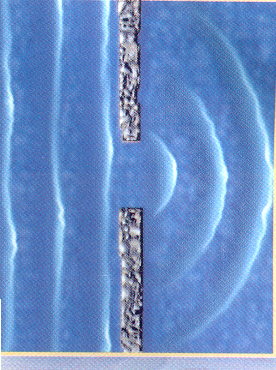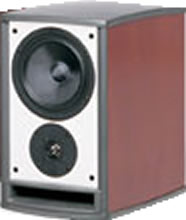This little document was written as a Supplementary Course Note for the course PHY132F - Introduction to Physics II.
All section and equation numbers refer to Randall D. Knight Physics for Scientists and Engineers, 2nd ed. (Pearson Addison-Wesley, 2008).
We have dropped the details of diffraction from the syllabus. The dropped material appears in the text in §22.4 and §22.5. However, there are some qualitative aspects of the phenomenon of diffraction that we will wish to know, and this document discusses them.
You will want to recall that for two slit interference , the angle between successive maxima is approximately given by:
| Eqn 22.4 |
As discussed in class:
The photograph to the right shows a water wave propagating to the right and passing through a gap in a sea wall. As you can see, the wave spreads out after it has passed through the slit This phenomenon is called diffraction, and occurs for all waves. You can see in the photograph that the wavelength of the water waves is about the size of the width of the slit. You can also see that the amplitude of the diffracted wave is largest in the centre, and decreases as the magnitude of the angle from the horizontal increases. It turns out that, similar to the case for interference, as the width of the slit is decreased the diffraction pattern spreads out more, and as the width of the slit is increased the pattern gets squished. In fact, if the width or the slit is much much larger than the wavelength of the wave, essentially no diffraction occurs and the wave continues propagating as a plane wave. |
 |
These facts are used in the design of loudspeakers. Speakers that produce bass notes are called "woofers". They need to move a lot of air, so need to be big. Diameters of 30 cm or more are common. However, a typical high treble note has a frequency of 5000 Hz or so, which corresponds to a wavelength of 0.07 m. This is much less than the diameter required for a woofer, so if we try to use the woofer to generate a high frequency note the sound wave will beam straight ahead without significant diffraction. Thus you won't hear those notes unless you are right in front of the speaker. Thus speakers to produce high frequency notes, "tweeters", must have a much smaller diameter than required for the woofer. In the speaker to the right the woofer is above and the tweeter is below. A simple electric circuit inside the enclosure directs low frequencies to the woofer and high frequencies to the tweeter. |
 |
This document was written by David M. Harrison, Dept. of Physics, Univ. of Toronto, david.harrison@utoronto.ca in January 2009.
The picture of water wave diffraction is by Prof. Joseph Alward, http://sol.sci.uop.edu/~jfalward/soundinterference/soundinterference.html and is used by permission.
The loudspeaker is a PSB Platinum M2.
This document is Copyright © 2009 David M. Harrison
This is $Revision: 1.1 $, $Date: 2009/01/17 12:15:44 $ (y/m/d UTC)
This work is licenced under a Creative
Commons Licence. |